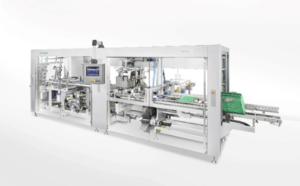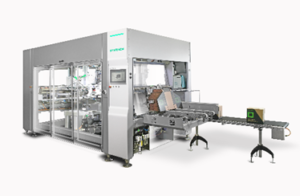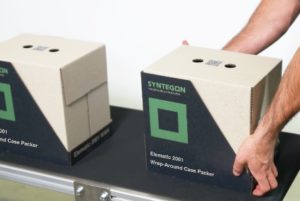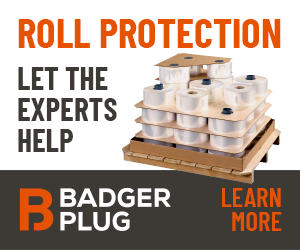Meeting All Demands: Syntegon Technology Reports on the Challenges of Secondary Packaging for Home Products
They perform valuable services at home: wet wipes, air fresheners, tissues and insect control products ensure freshness, hygiene, and health on a daily basis. But first, they must find their way from the manufacturers to the consumers. Robust and attractive secondary packaging plays a decisive role, as it provides for both safe transport and an attractive presentation at the point of sale. Bernhard Vaihinger, product manager for case packers at Syntegon Technology, explains which key factors need to be considered in the packaging process – and how the company is responding to current market trends.

Syntegon’s ergonomic Elematic 3001 WAH wrap-around case packer is ideal for packaging of large cases and offers great flexibility in formats and pack styles.
Home products come in all shapes and sizes. Do they have a common denominator, especially with regard to secondary packaging?
Vaihinger: They do. Whether manufacturers introduce shampoo or adhesive strips to the market, they all want to sell their products. Packaging takes on a double role: first, it has to make sure that products arrive at supermarkets, drugstores, and shops unharmed and in good shape. Second, products should also attract consumers’ attention trough an appealing look at the point of sale, especially in high-wage countries like Central and Western Europe. Display or tray packaging in particular highlight the product brand and encourage consumers to purchase them. At the same time, display packaging provides improved stability on the shelf. Trays can also be set up very quickly and products are ready for sale immediately after arrival. Transport safety, an attractive presentation and quick shelf placement are requirements that any packaging for home products should meet.
Talking about requirements, what challenges does this packaging pose for manufacturers?
Since these solutions are intended to serve multiple purposes, manufacturers work with custom designed blanks. Moth traps are a good example: a leading manufacturer relies on packaging that meets both transportation and display requirements. A perforated line separates the upper part of this shelf-ready packaging so that the individual packages are visible on the shelf and the products are presented attractively. The challenge with one-piece shelf-ready packaging, however, is the size and length of the perforation. Blanks are often thin and fragile due to the strong perforation. If not processed gently, they will tear during the folding process. This results in unnecessary product waste, which could be avoided by using appropriate technologies.

The Elematic 2001 Series can handle solid and corrugated cardboard made from recycled paper and alternative packaging materials, even in a more bent state than usual.
How can this be avoided? And how can these sophisticated blanks be processed?
Through form-fitting folding movements during the forming process, even at high processing speeds. It is important to have workflows that match the forming specifications of the blanks and prevent tearing or breaking, for example. Machines must be adaptable to be calibrated to the cut and crease lines as well as the perforations of the blank. With the Elematic 2001 Wrap-Around (WA), Syntegon has developed a fully automated single-level case packer with product infeed and grouping, which enables packaging from simple one-piece wrap-around cases to shelf-ready two-piece cases. With speeds of up to 40 cases per minute and a feeding rate of up to 600 products per minute, it is one of the fastest case packers on the market. Thanks to a special Elematic Click system, the formats of our case packer can be changed quickly and easily.
Speed and gentle handling are important criteria, but not the only ones. What about high flexibility, especially in a market characterized by varying pack styles and sizes?
Frequent changes between different packaging formats are part of the daily routine for many manufacturers. A well-known supplier of wet wipes, for example, sells them in twelve different packaging configurations. It was this variety – vertical and horizontal grouping, single-row or multi-row arrangement within the multipack – that made the manufacturer address the issue of format changeover. To cover the maximum format range and enable fast changeovers, both the Elematic 2001 and Elematic 3001 were suitable for packaging wet wipes. Since the wet wipes cover a large format range, the Elematic 3001 is ideal as an ergonomic wrap-around case packer for medium to large packaging – and also offers great flexibility in formats and packaging styles.
Secondary packaging holds high innovation potential. What implications does this have for an equipment supplier like Syntegon Technology?
We work closely with our customers and are always up to date with the current market trends. Food retailers have their own requirements for products and packaging. They want to consolidate market growth, a goal we also take into account. In addition to the Elematic Click system, we have developed an approach to produce one-piece display packages on existing Syntegon case packers. This development was initially driven by the request of a US customer. To ensure attractive display packaging on the shelves with minimum packaging material, Syntegon developed the one-piece display pack style “DisplayWrap” (patent pending), which is becoming increasingly popular in the US. We benefit from the fact that our case packers are flexible and designed for a wide product portfolio in both classic food and non-food applications.

The trend towards sustainable packaging materials is gaining ground: Syntegon machines can produce alternative packaging solutions, for example corrugated cardboard made from grass fibers.
Which market trends are most important and how is Syntegon Technology responding to them?
Independent of the customer, the trend towards sustainable packaging materials is gaining ground. Solutions based on grass, coconut or sugar cane fiber are slowly but surely replacing plastic materials. Paper is also conquering new areas of application beyond secondary packaging, for example in blister packaging. The idea here is for paper to replace plastic. We are modifying our machines accordingly: the Elematic 2001 series can process solid and corrugated cardboard made from recycled paper and alternative fiber materials, even in a more bent state than usual.
How does that work?
By fixing the blanks with mechanical clamps and transporting them from the magazine to the folding station with full control. This allows the Elematic 2001 to process blanks with a significantly greater bend than the usual three percent. One of our customers confirmed that the machine is even able to work with a ten percent bend at full machine speed. The result is less waste and a more sustainable production. We are also working on packaging that is especially suitable for e-commerce. Packaging is more and more frequently taking the direct route from the manufacturer to the consumer, involving less handling interfaces, like logistic centers. These so-called “direct parcels” need to be more resistant than those that are first palletized in the logistics center and prepared for transport. So we are also designing solutions to meet tomorrow’s transport requirements.







